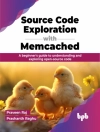Multimedia on Symbian OS is the only book available to
discuss multimedia on Symbian OS at this level. It covers key areas
of multimedia technology, with information about APIs and services
provided by Symbian OS. Other key features include details of UI
platform-specific APIs from S60 and UIQ.
This pioneering book covers each of the key technologies
available (such as audio, video, radio, image conversion, tuner and
camera) at a high level, to give the reader context, before
drilling down to details of how to use each of them. The book
includes code samples which are available for download on a website
and cover key APIs with detailed description of each. Additional
information includes the evolution of multimedia on Symbian OS from
previous versions to the current (v9.5) and plans for the
future.
Chapters include:
* Architecture of Multimedia on Symbian OS
* Onboard Camera
* Multimedia Framework of both Video & Audio
* Image Converter Library
* The Tuner
İçerik tablosu
Foreword.
About this Book.
Authors’ Biographies.
Authors’ Acknowledgements.
Symbian Press Acknowledgments.
Code Conventions and Notations.
1 Introduction.
1.1 The Convergence Device.
1.2 Transformation of the Media Industry.
1.3 Symbian OS.
1.4 The Cutting Edge.
1.5 Evolution of the Multimedia Subsystem in Symbian OS.
1.6 A Peek into the Future.
2 Multimedia Architecture.
2.1 The ECOM Framework.
2.2 Platform Security.
2.3 The Content Access Framework.
2.4 Multimedia Subsystem.
2.5 Future Multimedia Support.
3 The Onboard Camera.
3.1 Introduction.
3.2 Accessing the Camera.
3.3 Camera Control.
3.4 Displaying the Viewfinder.
3.5 Capturing Still Images.
3.6 Capturing Video.
3.7 Error Handling.
3.8 Advanced Topics.
4 Multimedia Framework: Video.
4.1 Video Concepts.
4.2 Symbian OS Video Architecture.
4.3 Client API Introduction.
4.4 Identifying Video Controllers.
4.5 Controlling Video Playback.
4.6 Controlling Screen Output.
4.7 Getting Video Information.
4.8 Accessing Metadata.
4.9 Controlling the Audio Output.
4.10 Streaming Playback.
4.11 Recording Video.
4.12 Controlling the Video that Is Recorded.
4.13 Controlling the Audio that Is Recorded.
4.14 Storing Metadata.
4.15 Custom Commands.
4.16 Examples and Troubleshooting.
5 Multimedia Framework: Audio.
5.1 Introduction.
5.2 Audio Input and Output Streams.
5.3 Audio Player Utility.
5.4 Audio Recorder Utility.
5.5 File Conversion.
5.6 Tone Utility.
5.7 Dev Sound.
5.8 Audio Policies.
5.9 Priority Settings.
5.10 Miscellaneous.
6 Image Conversion Library.
6.1 Introduction.
6.2 Decoding Images.
6.3 Encoding Images.
6.4 Displaying Images.
6.5 Transforming Images.
6.6 Native Bitmap Operations.
6.7 Miscellaneous APIs.
7 The Tuner API.
7.1 Introduction.
7.2 Getting Started.
7.3 Basic Use Cases.
7.4 Future Technologies.
7.5 Sample Code.
8 Best Practice.
8.1 Always Use an Active Scheduler.
8.2 Use APPARC to Recognize Audio and Video.
8.3 Don’t Use the Video Player to Open Audio Files.
8.4 Know that MMF and ICL Cannot Detect Some Formats.
8.5 Don’t Use CMda Audio Output Stream for Network
Streaming.
8.6 Use CMda Audio Player Utility to Play Tone Sequence Files.
8.7 Use CMda Audio Player Utility to Play Clips.
8.8 Don’t Hardwire Controller UIDs in Portable Code.
8.9 Set Controller Thread Priorities Before Playing or
Recording.
8.10 Recognize that Behavior Varies when Several Clients Are
Active.
8.11 Understand that the System is Based on Plug-ins.
8.12 Use RFile and TMMSource Instead of Passing a File Name.
8.13 Consider the Volume Control.
8.14 Know When to Use Threaded Requests on ICL.
8.15 Don’t Have too many Clients.
8.16 Understand the Multi-heap Problem.
References and Resources.
Index.
Yazar hakkında
Adi Rome has a BA in Computer Science from Tel Aviv
University. After a spell in teaching, she worked in Quality
Assurance, moving to analysis, design and implementation of
embedded systems, before joining Symbian in 2004. As the multimedia
guru within the Developer Services team she provides technical
consultancy across all areas of Symbian OS, with special emphasis
on hardware. Adi was responsible for communicating Symbian’s
roadmap to silicon and multimedia partners, and also led Symbian’s
component validation program. Away from technical work Adi has been
involved in setting up the Symbian China partner-consulting
organization and is in much demand for her presentation skills,
having given sessions at a wide range of partner and industry
events, including 3GSM World Congress.
Mark Wilcox has been playing with computers since his dad
bought a ZX81 when he was four. He wrote his first multimedia
application (a three room text adventure with sound effects!) on an
Acorn Electron when he was seven. Mark has a Masters degree in
Mathematics, following this up with a research postgraduate
in Cybernetic Intelligence. In 2001 he started developing software
for mobile phones and since then has been involved in handset
development projects for Ericsson, Fujitsu, Nokia, Panasonic and
Samsung. During this time he’s worked on everything from a
GPRS stack, device drivers and a power management server to
messaging applications and the code that draws the soft keys. It
was while working as a Software Architect for Nokia’s
Multimedia business unit, developing their flagship Nseries
products, that Mark developed his interest in the multimedia
capabilities of Symbian OS. Mark became an Accredited Symbian
Developer and a Forum Nokia Champion in 2007.












